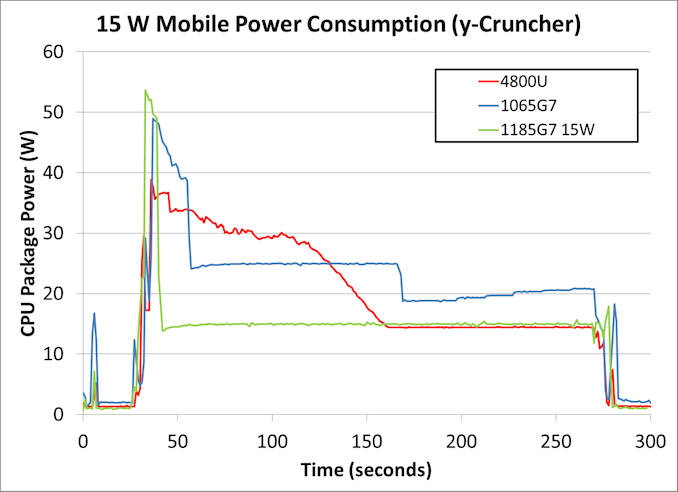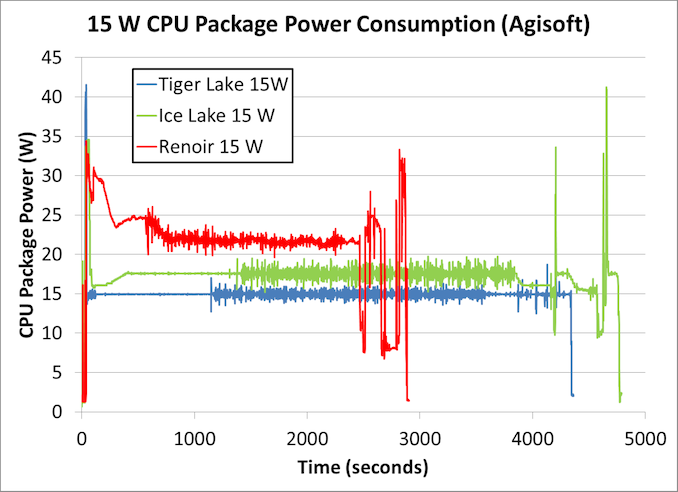Intel’s Tiger Lake 11th Gen Core i7-1185G7 Review and Deep Dive: Baskin’ for the Exotic
by Dr. Ian Cutress & Andrei Frumusanu on September 17, 2020 9:35 AM EST- Posted in
- CPUs
- Intel
- 10nm
- Tiger Lake
- Xe-LP
- Willow Cove
- SuperFin
- 11th Gen
- i7-1185G7
- Tiger King
Comparing 15 W TGL to 15 W ICL to 15 W Renoir
Despite the hullaballoo with the 28 W numbers on Tiger Lake, we suspect that most OEMs will still be positioning the hardware inside chassis built for the 15 W ultraportable market. This is where most of Intel’s OEMs have had success over the last decade, as the lower cooling requirements allow for a more user-friendly design. At 28 W, there is more of a cross-over into laptops that have discrete graphics options, and the main company that has succeeded in offering 28 W laptops without discrete graphics has been Apple - most Intel partners, if they want discrete graphics, end up looking at the 45 W processors with more cores.
So in that respect, our main battle should occur between the products built for 15 W. To that end we have been able to put the three together that will command this holiday season’s offerings: Ice Lake, Tiger Lake, and AMD’s Renoir.
- For our Ice Lake system, we have the Microsoft Surface Laptop 3. This has the top-of-the-line quad-core Core i7-1065G7, along with 16 GB of LPDDR4X-3733. Base 1.3 GHz, Turbo 3.9 GHz. Because this is an OEM design, Microsoft have determined the PL1 and PL2 values, and so they might be different from a ‘base’ design, however this is data from a real system.
- The Tiger Lake system is our Reference Design from Intel, running the quad-core Core i7-1185G7 at 15 W TDP mode. It has 16 GB of LPDDR4X-4266. Base 1.8 GHz, Turbo 4.8 GHz.
- Our AMD Renoir system is one of the most premium examples of AMD’s Ryzen Mobile in a 15W form factor, the Lenovo Yoga Slim 7 with the eight-core Ryzen 7 4800U processor. Even when set to the highest performance mode, the system still operates with a 15 W sustained power draw. It comes equipped with 16 GB of LPDDR4X-4266. Base 1.8 GHz, Turbo 4.2 GHz.
Compute Workload
For our 15 W comparisons, we can look again at the same benchmarks as the previous page. First up is y-Cruncher, an AVX2/AVX512 compute workload that tasks the CPU and the memory by calculating 2.5 billion digits of Pi, and requires ~11 GB of DRAM.
As we saw on the previous page, our Tiger Lake system in green at 15 W turbos up to ~53 watts before very quickly coming down to 15 W for the rest of the test.
The Microsoft Surface Laptop 3, by virtue of an OEM system, has different behavior - it turbos for longer, settles into a short turbo limit of 25 W, and then after about two minutes comes down to 20 W. The system then appears to opportunistically up the power draw until the end of the test, likely due to detecting extra thermal headroom.
The AMD Renoir processor does not turbo as high, peaking at only 38.9 W. Over the course of the next 100 seconds or slow, we see a small ramp down to just under 30 watts, before a more consistent decline over 30 seconds to 15 W, before staying at 15 W for the full test. The Renoir here has eight cores rather that four, but is running AVX2 rather than AVX-512 code.
The results are as follows:
- Ice Lake: 233 seconds, for 6072 joules, averaging 26.1 W
- Tiger Lake: 241 seconds for 4082 joules, averaging 17.0 W
- Renoir: 234 seconds for 5386 joules, averaging 23.0 W
All three systems perform the test in roughly the same amount of time, however the Tiger Lake system is very much ahead for efficiency. Tiger Lake effectively shaves off a third of the power from the previous generation Ice Lake system. We weren’t expecting this much of a jump from Ice Lake to Tiger Lake, but it would appear that Intel has done some work on the AVX-512 unit, and is putting that new high-performance transistor to use.
Professional ISV Workload
Moving onto the Agisoft test - as mentioned on the previous page, this is a 2D image to 3D modeling workflow where the algorithm comes in four stages, some of which prefer full multi-thread throughput, while others are more frequency and memory sensitive.
First, the Renoir finishes in almost half the time, mostly due to the fact that it has double the number of cores - there is no AVX-512 codepath in this test, and so all the processors rely on a mix of SSE, AVX, and perhaps some AVX2. That aside, the turbo behavior of Renoir is very interesting - we get almost 10 minutes of higher-than-base performance before the algorithm sets into a routine, hovering around 22 W. Because this test doesn’t attack the vector units as hard as the previous test, it may be a case that the Renoir system can manage the power distribution a bit better between the eight cores, allowing for the higher turbo.
Between the Ice Lake and the Tiger Lake, from the graph it would appear to be a double win for Tiger Lake, finishing in a shorter time but also consuming less power. The results are:
- 15 W Renoir: 2842 seconds for 62660 joules
- 15 W Ice Lake: 4733 seconds for 82344 joules
- 15 W Tiger Lake: 4311 seconds for 64854 joules
In this case, it’s a win for Renoir - a lot shorter time, and better power to boot, derived from the eight cores built on TSMC 7nm. Tiger Lake still represents a good jump over Ice Lake, offering 10% better performance at only 79% of the power, or a 13% increase in performance efficiency.












253 Comments
View All Comments
Rtx dude - Monday, September 28, 2020 - link
Thank youStingkyMakarel - Friday, September 18, 2020 - link
anyone tried running multiple single threaded app on Intel and AMD?dsplover - Friday, September 18, 2020 - link
Yes. A couple actually which each get a Core assignment. I’m an audio geek that came from using a PC for streaming from HDD’s (Seagate 10k SCSI Cheetahs) to a software based synthesizer enthusiast where single core performance is crucial.Started with AMD MPs/Tyan Tiger and Coppermine 1GHz CPU’s.
I’ve concluded that CPU Cache or 4.4GHz on an Intel is optimal.
Latency from extra cores causes me to adjust audio buffer sizes to compensate which I noticed on the Intel Quads. Conroe Dual Cores were faster for my core locked synths. A larger CPU cache overcame the inefficiencies when i7 Bloomdales hit the market.
Matisse 3800X was a great chip, but more than the 8 Cores was the same latency issues.
Looking forward to the Cezanne and maybe a Vermeer as I don’t need killer graphics, 2D is fine. Actually AST ASpeed 2500 Server chips on Supermicro and ASRock workstation/server boards is fine.
What I seek is the single core performance crown. Intel i7 4790k’s are still in my racks. To make me jump to new builds is a larger cache from Intel. Tiger Lake at 50watts looks great for my needs. 4.4GHz is as good as it gets. But even my ancient i7 5775C using a discrete GFX card, using the 128MB L4 cache for audio (running at 3.3GHz) was on par with the 4GHz 4790k.
So for me the CPU/IPC gains are appreciated, but cache and CPU running at 4+ GHz are really beneficial.
Tiger Lake or Cezanne will finally show me the results I need to upgrade.
Intel and AMD can add all of the Cores they want. Single core performance or larger cache to overcome the latency of additional Cores will mean I can run more high end Filters to shape my sounds with.
dromoxen - Saturday, September 19, 2020 - link
For me these are still too weak GFx despite 2x .. When they can match or better my gtx960 they might have a customer. Otherwise I''ll stick to a downclocked ryzen 4000+gtx960 ..I want low low heat output , and a single APU would be ideal ..ASROCK deskmini styleee .Gondalf - Friday, September 18, 2020 - link
Not only but the claimed 10/15% IPC boost of Zen 3 will be barely enough to be near with Intel clock to clock. Still Intel process clock clearly better, so the upcoming 8 cores Tiger Lake will be an easy winner over an eight core Zen 3.To be noticed, in productive benches Intel core destroy badly Zen. Likely the cache structure is done to perform great on standard laptop SW.
As usual a core have to be SW optimized, definitively not synthetic benches optimized. More or less the reason Xeon is right now a big winner on Epyc in the 32 cores/cpu market (the larger).
Spunjji - Friday, September 18, 2020 - link
You say this every time a new AMD processor is due, and every time you're wrong, and the next time you say the same damned things again. 😑close - Friday, September 18, 2020 - link
Subjective opinion time. Ian & Andrei, leaving aside individual scores (great ST performance for Intel, great MT performance for AMD), which one would you buy for day to day "regular" work?I've read opinions like "I made it painfully clear that the top-of-the-line Intel CPU at its highest cTDP was only going up against a mid-grade Ryzen" and there's still room for personal opinion here. Should you have to buy one now "money no issue" and ignoring specialized fields (like AI stuff where AVX-512 makes sense) which would you put your money on?
Spunjji - Friday, September 18, 2020 - link
I look forwards to the day when this Intel shill troll gets banned.melgross - Sunday, September 20, 2020 - link
Oh, come on. We have both AMD and Intel trolls here. They cancel out.Spunjji - Sunday, September 20, 2020 - link
There's being a fanboy, then there's creating an entire alter ego as some desperate attempt at satire that is inherently self-satirizing of the person running the account. I find this one deeply tiresome.